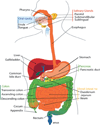Microbial biofilms and gastrointestinal diseases
- PMID: 23620117
- PMCID: PMC4395855
- DOI: 10.1111/2049-632X.12020
Microbial biofilms and gastrointestinal diseases
Abstract
The majority of bacteria live not planktonically, but as residents of sessile biofilm communities. Such populations have been defined as 'matrix-enclosed microbial accretions, which adhere to both biological and nonbiological surfaces'. Bacterial formation of biofilm is implicated in many chronic disease states. Growth in this mode promotes survival by increasing community recalcitrance to clearance by host immune effectors and therapeutic antimicrobials. The human gastrointestinal (GI) tract encompasses a plethora of nutritional and physicochemical environments, many of which are ideal for biofilm formation and survival. However, little is known of the nature, function, and clinical relevance of these communities. This review summarizes current knowledge of the composition and association with health and disease of biofilm communities in the GI tract.
© 2012 Federation of European Microbiological Societies. Published by Blackwell Publishing Ltd. All rights reserved.
Figures




Similar articles
-
The Challenging World of Biofilm Physiology.Adv Microb Physiol. 2015;67:235-92. doi: 10.1016/bs.ampbs.2015.09.003. Epub 2015 Oct 27. Adv Microb Physiol. 2015. PMID: 26616519
-
Evolving concepts in biofilm infections.Cell Microbiol. 2009 Jul;11(7):1034-43. doi: 10.1111/j.1462-5822.2009.01323.x. Epub 2009 Apr 6. Cell Microbiol. 2009. PMID: 19374653 Review.
-
Microbial biofilms in ophthalmology and infectious disease.Arch Ophthalmol. 2008 Nov;126(11):1572-81. doi: 10.1001/archopht.126.11.1572. Arch Ophthalmol. 2008. PMID: 19001227
-
Gastrointestinal Biofilms: Endoscopic Detection, Disease Relevance, and Therapeutic Strategies.Gastroenterology. 2024 Nov;167(6):1098-1112.e5. doi: 10.1053/j.gastro.2024.04.032. Epub 2024 Jun 12. Gastroenterology. 2024. PMID: 38876174 Review.
-
Biofilm dispersal: mechanisms, clinical implications, and potential therapeutic uses.J Dent Res. 2010 Mar;89(3):205-18. doi: 10.1177/0022034509359403. Epub 2010 Feb 5. J Dent Res. 2010. PMID: 20139339 Free PMC article. Review.
Cited by
-
Identifying Microbiota Signature and Functional Rules Associated With Bacterial Subtypes in Human Intestine.Front Genet. 2019 Nov 15;10:1146. doi: 10.3389/fgene.2019.01146. eCollection 2019. Front Genet. 2019. PMID: 31803234 Free PMC article.
-
Targeting a bacterial DNABII protein with a chimeric peptide immunogen or humanised monoclonal antibody to prevent or treat recalcitrant biofilm-mediated infections.EBioMedicine. 2020 Sep;59:102867. doi: 10.1016/j.ebiom.2020.102867. Epub 2020 Jul 7. EBioMedicine. 2020. PMID: 32651162 Free PMC article.
-
Gastric bacterial Flora in patients Harbouring Helicobacter pylori with or without chronic dyspepsia: analysis with matrix-assisted laser desorption ionization time-of-flight mass spectroscopy.BMC Gastroenterol. 2018 Jan 26;18(1):20. doi: 10.1186/s12876-018-0744-8. BMC Gastroenterol. 2018. PMID: 29373960 Free PMC article.
-
Abundance and transmission of antibiotic resistance and virulence genes through mobile genetic elements in integrated chicken and fish farming system.Sci Rep. 2025 Jul 1;15(1):20953. doi: 10.1038/s41598-025-92921-w. Sci Rep. 2025. PMID: 40595289 Free PMC article.
-
Extracellular matrix structure governs invasion resistance in bacterial biofilms.ISME J. 2015 Aug;9(8):1700-9. doi: 10.1038/ismej.2014.246. Epub 2015 Jan 20. ISME J. 2015. PMID: 25603396 Free PMC article.
References
-
- Adams RJ, Heazlewood SP, Gilshenan KS, O’Brien M, McGuckin MA, Florin TH. IgG antibodies against common gut bacteria are more diagnostic for Crohn’s disease than IgG against mannan or flagellin. Am J Gastroenterol. 2008;103:386–396. - PubMed
-
- Apostolakis LW, Funk GF, Urdaneta LF, McCulloch TM, Jeyapalan MM. The nasogastric tube syndrome: two case reports and review of the literature. Head Neck. 2001;23:59–63. - PubMed
-
- Bauer TT, Torres A, Ferrer R, Heyer CM, Schultze-Werninghaus G, Rasche K. Biofilm formation in endotracheal tubes. Association between pneumonia and the persistence of pathogens. Monaldi Arch Chest Dis. 2002;57:84–87. - PubMed
-
- Baumgart M, Dogan B, Rishniw M, et al. Culture independent analysis of ileal mucosa reveals a selective increase in invasive Escherichia coli of novel phylogeny relative to depletion of Clostridiales in Crohn’s disease involving the ileum. ISME J. 2007;1:403–418. - PubMed
Publication types
MeSH terms
Grants and funding
LinkOut - more resources
Full Text Sources
Other Literature Sources

